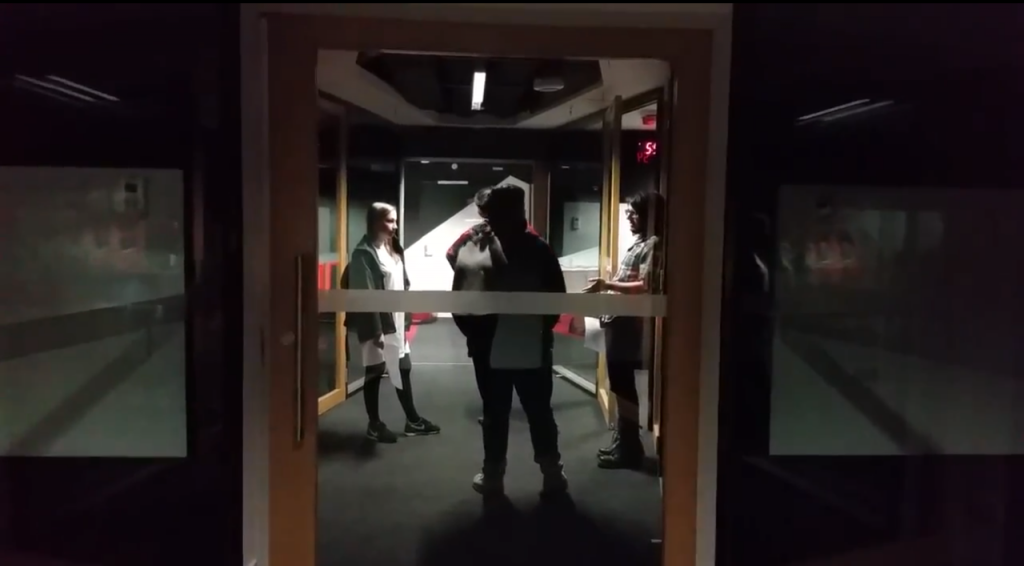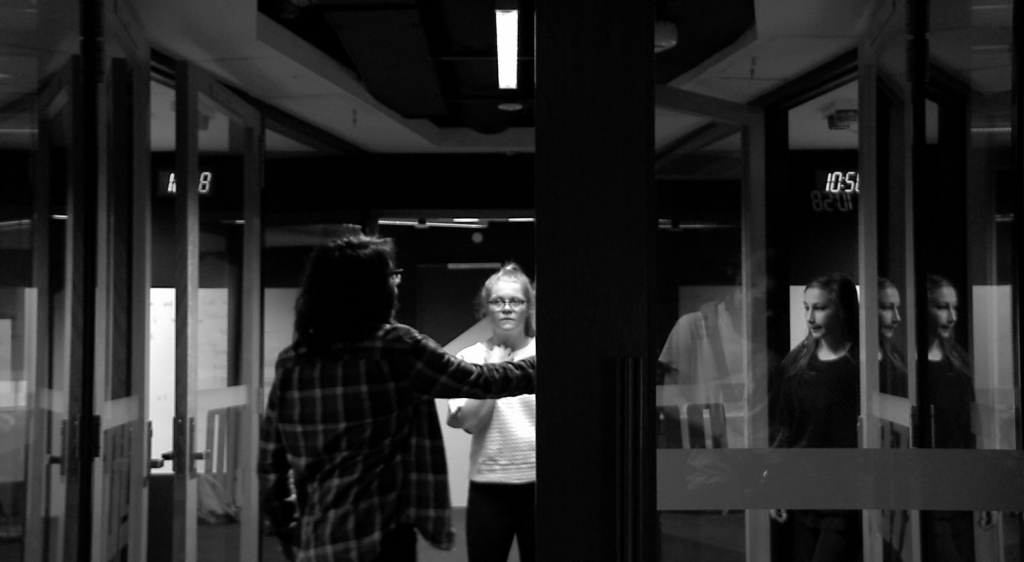My edit of ‘Doors’ begins with a mid long shot (that becomes a mid closeup) of Van walking down the stairs. Originally we were planning to follow this shot with a closeup of Van’s feet to create more of a montage sequence, but unfortunately we ran out of time to shoot it. I think this initial shot would have worked better if we had let Van walk out of frame at the end, so then when she walks into frame in the next shot, the space and time of the scene would appear to be continuous. Although I included a cross dissolve transition to represent the passing of time, in retrospect, I think a blunt cut would have made my edit look more polished. At the time I was worried that joining the two shots (the one where Van walks down the stairs and the one where Van walks towards the hallway of doors) would create a jump cut. But after watching other’s edits of the same scene, I realised that cutting straight from one shot to the other looked fine.
The next shot is a hand held mid closeup of Van walking towards the hallway of doors and checking if anyone is there. Although the circular motion of the camera is quite shaky as it follows Van around the wall, I think it adds to the suspense of the scene. The movement is rather disorienting, which evokes a sense of anxiety that seems to suit Van’s emotional state. The intimacy of the framing also intensifies the action in this shot. However, I think the camera coverage could have been slightly improved if the camera had moved around Van a touch more so that we could see Cine coming out of the room; or if the camera was able to capture the characters’ reflections in the opposing glass door.
As Van abruptly jumps behind the wall to hide from Cine, the scene cuts to a wider long shot of Cine and a mid long shot of Van. By cutting the scene on this action, perceived continuity is created between the two shots, as well as a heightened sense of drama (the editing helps to quicken the pace of the scene and emphasises the character movement). This shot draws the audience’s attention to Van, because she is situated in the front-most plane of the composition and is starkly contrasted against the white wall behind her. However, once Cine walks forward, she positions herself on the same plane as Van so that both characters appear to have equal ‘dominance’ in the scene. Both characters then exit to the right side of frame.
In the next shot, the characters enter from the left side of frame. Although this is technically breaking the 180 rule, I think it makes logical (temporal and spatial) sense because the characters still appear to be on the same side of each other as they were in the previous shot. I think I could possibly have gotten rid of the first section of this scene, where Van and Cine walk down the hallway, and just cut straight to when they open the door. Originally I had thought that this discontinuity would appear jarring for viewers, but now I feel like it is uninteresting to witness the characters simply walking down the hall. By cutting straight to an ‘event’ I would have quickened the pace of the scene and in turn held the audience’s attention for longer.
The rest of the scene plays out as a mid long shot, which incorporates many other frames within frames. To add a sense of surprise we had X walk in from behind camera. This is probably my favourite frame of the scene. I love how X is back lit, which creates an ominous silhouette, and has his arm positioned so that he frames Van in the shot as well. Generally I try to refrain from making my films black and white, unless the colour scheme is somehow motivated by the narrative. I felt that this palette suited this scene because it heightened the ‘film noir’ undercurrent of the storyline (our group felt like this scene could belong to a murder mystery film). The down lighting and the silhouette of X also lends itself to the film noir genre, which is historically filmed in black and white. Other than that, the colour grading helped to emphasise the contrast between characters. It draws the viewers attention to Van who stands out from the dark background because she wears a starkly white t-shirt. It also helped to create a unified sense of space. When viewed in colour, the shot on the stairs seems to be completely removed from the rest of the scene because the background is a lime green colour (whereas the rest of the shots were filmed with a white, black or glass background). This desaturation also aided in the ‘masking’ of the red recording light of the camera which could be seen in the reflection on the glass walls in a couple of the shots.
The opening of the sliding door in this shot serves the purpose of blocking the audience’s (and X’s) view of Cine, so that when she comes ‘out of hiding’ it makes sense that X is shocked and asks who she is. Although the framing here is relatively perfect in regards to X’s silhouette, I think there is too much room between Van’s head and the top of the frame (and eventually X’s when he moves away from the camera). I think the symmetrically of this composition works well, however, the positioning of the camera could have been brought slightly more forward (so it just caught the edges of the doorway), or pushed right back. Originally we had planned to actually shoot this sequence as a long shot to emphasise the hollow expanse of the hallway, but we ran into troubles with the sound equipment because it wasn’t able to reach the characters on the other side of the door. (Below is a photo we took during the pre-production stage).

Although we clearly had problems with the reflections of the crew in this space, I think the sliding door worked well in this scene because its movement is quite dynamic. It serves to ‘reveal’ Cine as she appears in the doorway, her reflection repeated and refracted in the opposing glass walls.
The door then ‘blocks’ Van, which focuses the audience on the conversation between X and Cine (below).

The slamming of all three doors creates a satisfying feeling of closure as the characters disappear from the frame. I think I could have magnified this action by simplifying the sound effect so that it sounded like one big, unified ‘bang’, instead of three slightly out of time slams. It also would have been better to cut straight to black, because the fade out of visuals seems almost too smooth for this abrupt ending.


